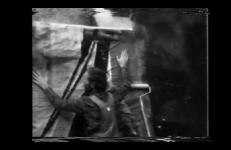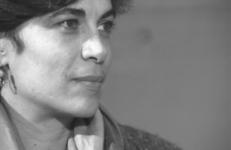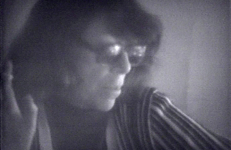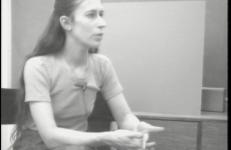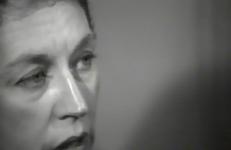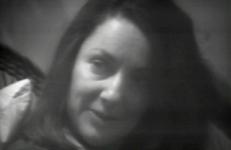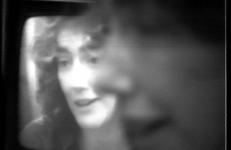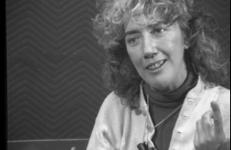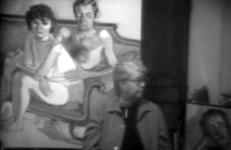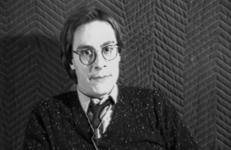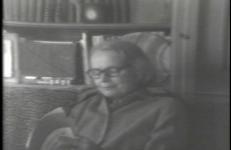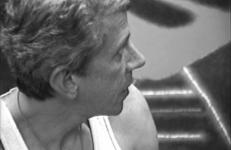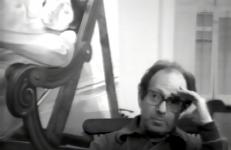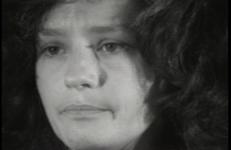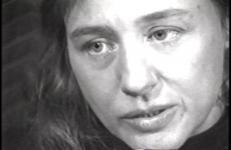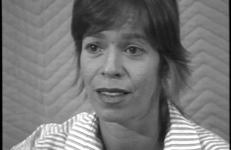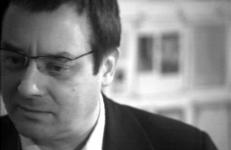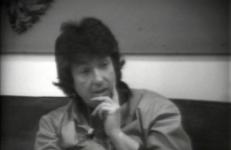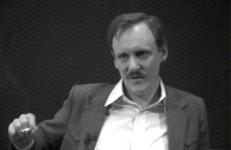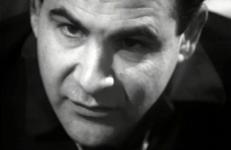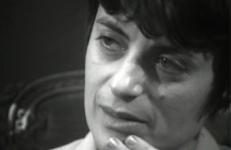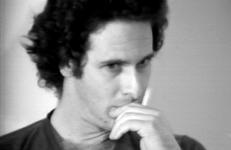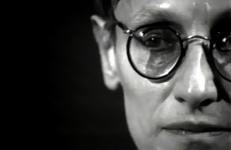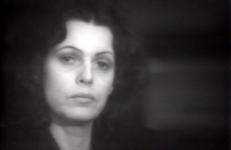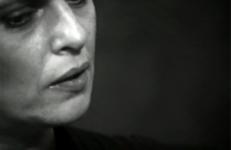West coast artists, Mike Mandel (b.1950) and Larry Sultan (1946-2009) became artistic collaborators in 1972 while both enrolled in the San Francisco Art Institute’s MFA program. This interview captures the duo’s camaraderie (look closely, they are wearing matching shirts!) and youthful optimism as they describe the impetus behind their California billboard installations of the early seventies.
Blumenthal/Horsfield Interviews
Mary Miss (b.1944) is an American environmental artist who works with concepts of illusion, distance, and perception. Her site-specific work frequently uses both ancient and modern architecture as references. Miss's 1977 installation Perimeters/Pavilions/Decoys at the Nassau County Museum of Art, served as one of Rosalind Krauss's inspirations when she defined postmodern sculpture in her article, "Sculpture in the Expanded Field."
Joan Mitchell (1925-1992) was a "second generation" abstract expressionist painter and printmaker. She was an essential member of the American Abstract expressionist movement, and one of the few female painters to gain critical and public acclaim in the era.
Meredith Monk (b.1942) has been composing, choreographing, and performing since the mid-1960s. Monk is primarily known for her vocal innovations, including a wide range of extended techniques, which she first developed in her solo performances prior to forming her own ensemble. Her voice has a unique timbre, which she explores through a capella singing and speech. As a dancer and choreographer, she creates hybrid, theatrical productions that incorporate ritualistic movements, lighting effects, and small props.
Linda Montano (b. 1942) is an American performance and video artist. At the source of’s work is her search for a personal harmony and balance. She seeks to synthesize the intuitive processes that transforms the private self with the rationality and pragmatism of the public persona, extending this synthesis to both art and life. Her avowed interest lies in "learning how to live better through life-like artworks," with personal growth evolving out of shared experience, role adoption, and ritual.
Ree Morton (1936-77) was an American artist working with large-scale mixed media installations. Her mature career was brief, extending from 1971 to 1977. However, her output and growth during these years was unusually large. This was the first of two interviews Lyn Blumenthal and Kate Horsfield conducted with Morton; the second was for the journal Heresies in 1977.
Elizabeth Murray (1940-2007) was an American painter, printmaker and draughtsman. She studied at the Art Institute of Chicago (1958–62) and at Mills College, Oakland, CA (1962–4). Elizabeth Murray’s paintings have been referred to as “dandyish abstraction.” Her work is distinctive in its use of color, shape, and surface to evoke human characteristics, personalities or humor.
Elizabeth Murray (1940-2007) was an American painter, printmaker and draughtsman. She studied at the Art Institute of Chicago (1958–62) and at Mills College, Oakland, CA (1962–4). Elizabeth Murray’s paintings have been referred to as “dandyish abstraction.” Her work is distinctive in its use of color, shape, and surface to evoke human characteristics, personalities or humor. Murray is particularly well known for her shaped canvases, which date from 1976, on to which are painted both figurative and non-figurative elements.
Alice Neel (1900-1984) is known for portrait paintings of well-known persons and eccentric New York street types. Neel worked as a figurative painter throughout the decades of WPA realism, postwar abstract expressionism, 1960s Pop, and 1970s minimalism. She persevered in her work despite a turbulent personal life and critical neglect that continued until the 1960s. Neel lived and worked in New York City from 1932 until her death in 1984.
Craig Owens (1950-1990) was a critic who wrote and lectured extensively on contemporary art. He showed particular interest in the issues of photography, postmodernism, feminism, and Marxist thought. A former associate editor for October and senior editor for Art in America, as well as professor of art history at Yale University and Barnard College, his writings were collected in Beyond Recognition: Representation, Power, and Culture (1994). Owens died of an AIDS-related illness in 1990.
Betty Parsons (1900-1982) was an influential art dealer in mid to late 20th century New York. She used her gallery as an influential advocate for the abstract avant-garde, and was renowned for championing new styles and new artists well before they received wider recognition or commercial success. Notable examples of Parson's circle include abstract expressionist giants Barnett Newman, Jackson Pollock, Mark Rothko and Clyfford Still.
Polish-American arist Ed Paschke (1939-2004) received his BFA from the School of the Art Institute of Chicago in 1961 and his MFA in 1970. Paschke was known as a member of the late-1960s Chicago Imagist movement, a group of artists who called themselves The Hairy Who, whose expressive style of figurative painting was rooted in outsider art, popular culture, and Surrealism. Paschke's fascination with the print media of popular culture led to a portrait-based art of cultural icons. Paschke used the celebrity figure, real or imagined, as a vehicle for explorations of personal and public identity with social and political implications.
Philip Pearlstein (b.1924) began painting figures in the 1960s and is known as a leading figure in American Realism. Throughout his career, Pearlstein's paintings evolved from an expressionistic style to a meticulously analytical vision. His work attempts to present the model as a documentation of the painting session, and his paintings are closely rendered under the existing studio lighting. Attuned to art history, Pearlstein is as interested in pattern and composition as he is in the body itself.
Arlene Raven (1944-2006) was a feminist historian, theoretician, poet, and art historian who has published numerous books on contemporary art and written criticism for The Village Voice and a variety of other newspapers, art magazines, exhibition catalogues, and scholarly journals since 1969. She is a pioneer in progressive education and was an architect of the educational programs of the Feminist Studio Workshop, an independent school. She is also the founder of the Women’s Caucus for Art, the Los Angeles Woman’s Building, and Chrysalis magazine.
Martha Rosler (b.1943) received her BA from Brooklyn College in 1965 and her MFA from the University of California, San Diego in 1974. Rosler has produced seminal works in the fields of photography, performance, video, installation, criticism, and theory. Committed to an art that engages a public beyond the confines of the art world, Rosler investigates how socioeconomic realities and political ideologies dominate everyday life. Rosler's work has entered the canon of contemporary art through a process of steady, stealthy infiltration. Lacking commercial gallery representation until 1993, her endeavors as a prolific essayist, lecturer, and political agitator enabled her agenda to trickle down through critical channels.
Painter, Susan Rothenberg (b.1945) is known for her poetic, atmospheric images. From her early horse paintings to her paintings of athletes and dancers, Rothenberg's works have always been subservient to the flatness and objectivity of her gesturally dense surfaces. In her paintings, image and surface combine in a private symbolism and restrained drama that is physically and emotionally intrusive. Rothenberg currently lives and works in New Mexico.
American painter, Robert Ryman (b. 1930) is associated wth the movements of monochrome painting, minimalism and conceptual art. The artist first moved to New York City from Nashville with the intention of becoming a jazz musician. In 1953 he took a temporary job—where he would ultimately work for seven years—as a guard at the Museum of Modern Art. Soon after, he would decide to devote his career towards painting. In his first paintings and collages from the mid-1950s, he experimented with material, color and brushwork, eventually reducing the painting to its barest elements.
Canadian-born artist Miriam Schapiro (b.1923) was one of the great forces behind the feminist art movement in Los Angeles. Originally painting in an Abstract Expressionist manner, she developed a new, more personal style of assemblage she called “femmage” as she became more politically involved. She was also one of the first scholars to create a curriculum on Feminist Art at CalArts. Through the use of large scale media and symbols emblematic of the female, she has battled to pay homage to women and their undervalued domestic traditions.
Peter Schjeldahl (b.1942) began writing his “poetical criticism” for Tom Hess at ArtNews in the mid 1960s. He has since written for both popular and specialized publications including The New York Times, Art in America, and The Village Voice, among others. In this interview from 1982, Schjeldahl discusses the critic’s relationship to the artist, the audience, artwork, and the professional community of art critics. He also reads some of his own poetry.Currently, Schjeldahl writes for The New Yorker and various art journals.
Joel Shapiro (b.1941) came to prominence in the early 1970s with his representational miniatures of everyday objects like chairs and houses. Since then he has become one of the most exhibited American sculptors. Shapiro’s vocabulary consists largely of rectangular volumes, with which he has created a body of work dancing on the line between abstraction and figuration. The human form has been a major theme in Shapiro’s geometric expression.
Hollis Sigler (1948–2001) was a Chicago-based artist. She received degrees from both Moore College of Art and the School of the Art Institute of Chicago. Her mature artistic style was faux-naïve, featuring paintings whose subjects, furniture and clothing set in doll-house type interiors and suburban landscapes, were stand-ins for the implicitly female figure. She was an openly lesbian artist and a prominent member of the faculty of Columbia College in Chicago.
Charles Simonds (b.1945) majored in art at the University of California at Berkeley. There he discovered an area of clay pits that had once provided the raw material for some of Manhattan's older buildings. He literally immersed himself in the subject, burying himself in a pool of wet clay to get a feel for the material. Simonds's sculptures are enchanting architectural minatures. Most are landforms with small chambers and towers; some are abstract organic shapes. Carefully built brick by tiny brick, Simonds's sculptures engage the child in everyone.
Best known for her drawings and prints, Nancy Spero (1926-2009) worked as an oil painter on both paper and canvas and with installations. As both artist and activist, Nancy Spero's career spanned fifty years. Spero was active in many radical groups including WAR (Women Artists and Revolution) and AIR (Artists in Residence), the first women’s cooperative gallery in New York. She was renowned for her continuous engagement with contemporary political, social, and cultur
Pat Steir (b.1938) is an American painter and printmaker, whose work has resisted artworld currents and factions for decades while maintaining enthusiastic critical support.
Pat Steir (b.1938) is an American painter and printmaker, whose work has resisted artworld currents and factions for decades while maintaining enthusiastic critical support. She graduated from Pratt in 1962 and in 1964 was included in the show Drawing at the Museum of Modern Art in New York and had her first solo exhibition at the Terry Dintenfass Gallery, New York. She first came to prominence in the 1970s, when her work concentrated on signs and symbols and was close to minimal and conceptual art.




